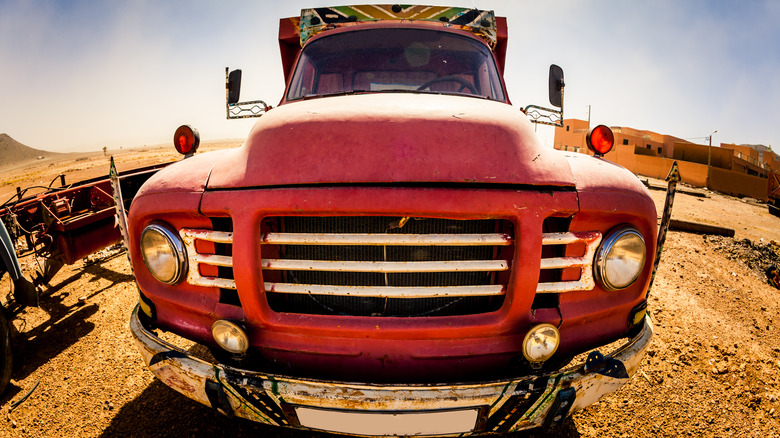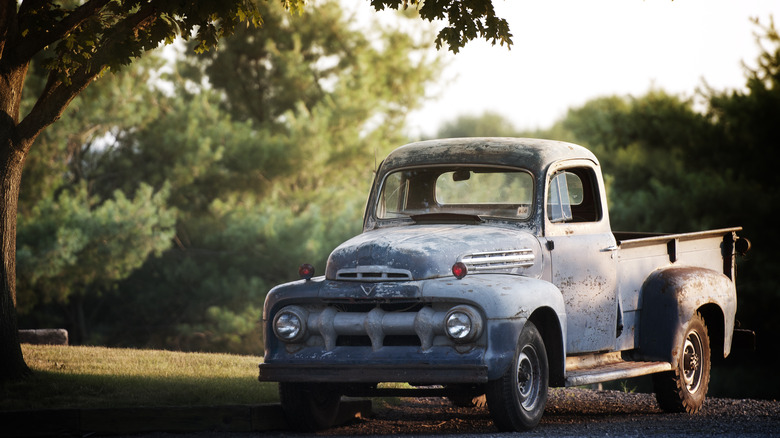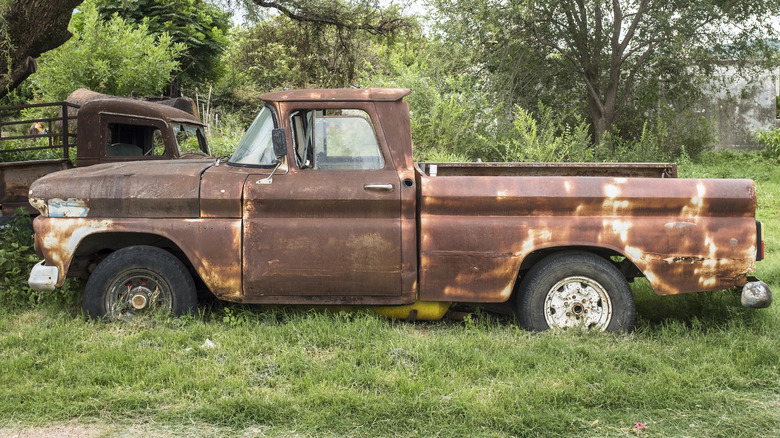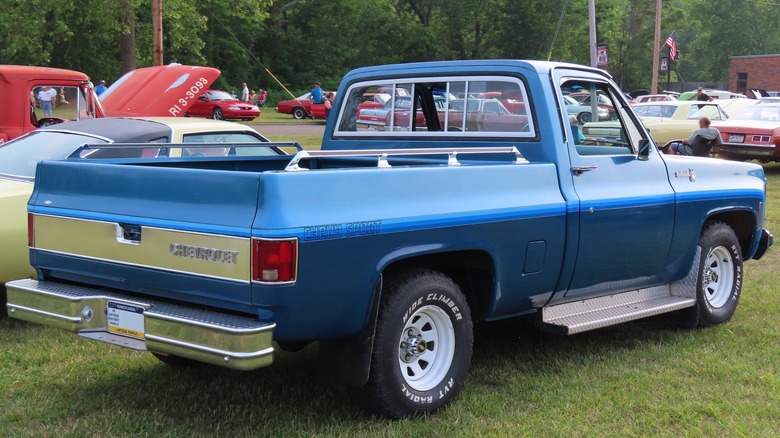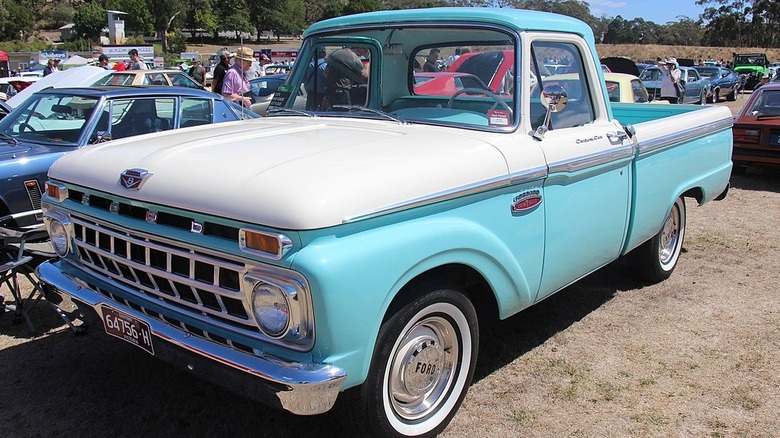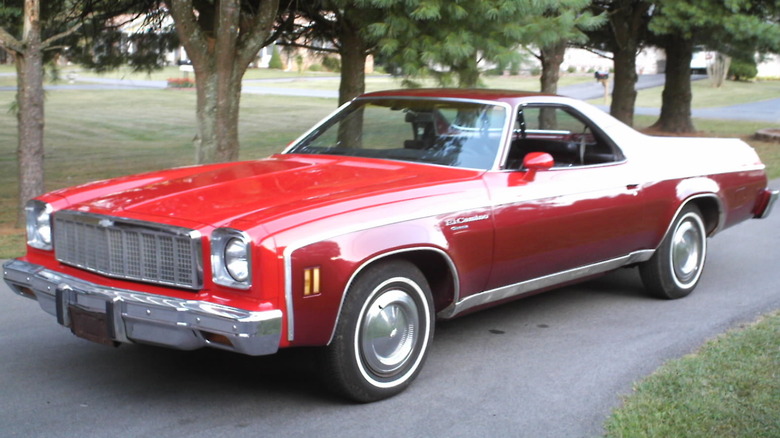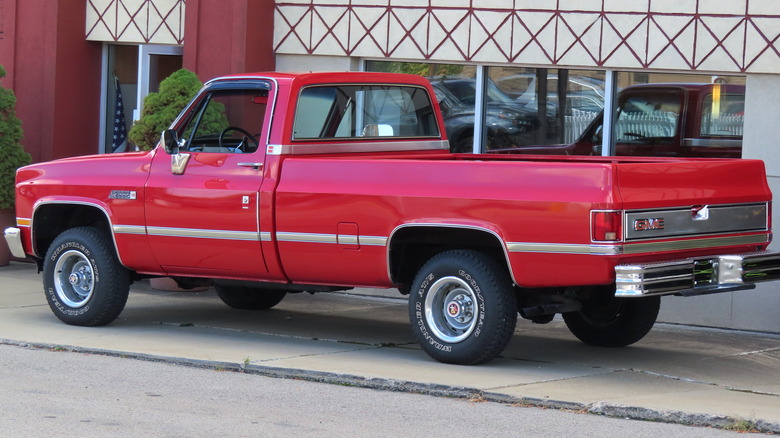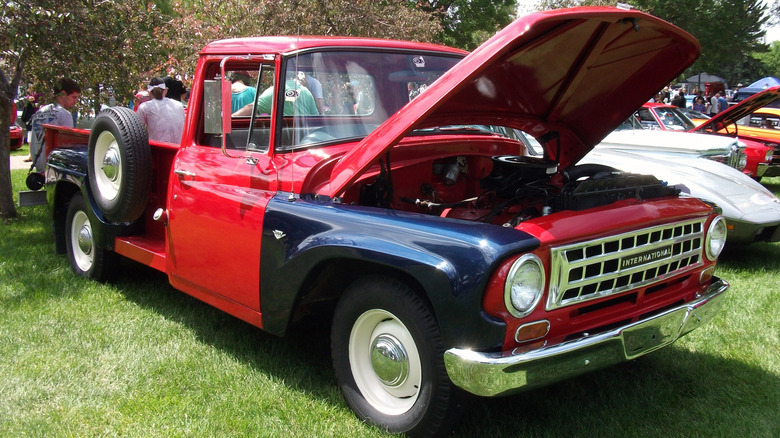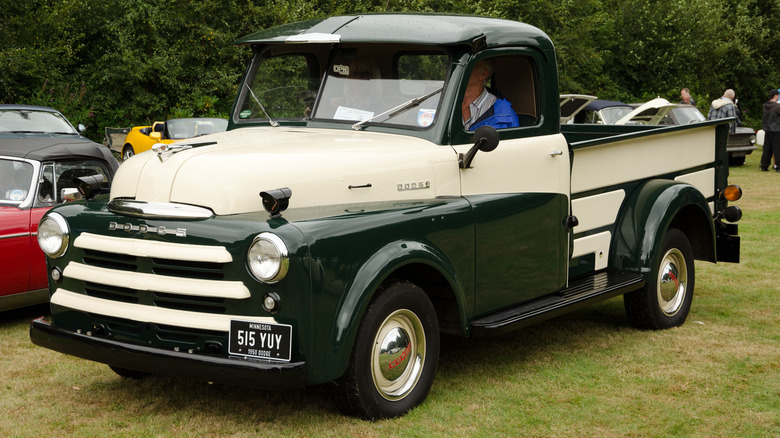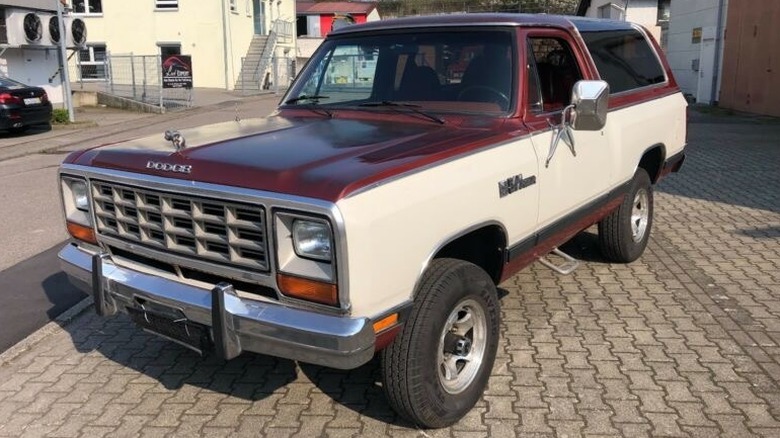7 Cheap Vintage Trucks To Consider For Your Next Resto-Mod Project
Over the better part of a century, the pickup truck has grown from a utilitarian necessity to a beloved part of American life. Pickup trucks have cemented their place as American icons, and the classic trucks of yesteryear have a particular spirit that inspires amateur and professional gearheads alike to bring them back to life. Classic vehicles evoke a certain feeling in those who appreciate them, but unfortunately, they often do not meet modern safety or performance standards.
Driving a classic might turn heads, but it's not always comfortable, quiet, or even safe. Over recent decades, resto-modding has become a popular method to revive vintage trucks into safe, fun, and gorgeous rides with performance that belies their appearance. Resto-mod, which stands for restoration and modification, sees builders injecting modern technology beneath the skin of classics while maintaining much of the vibe of the original car. Resto-modding combines the best of both worlds: the performance, comfort, and safety of modern driving alongside a vintage aesthetic.
Builders have resto-modded some of the most refined cars on the planet, but that doesn't mean it has to be that way. Vintage pickup trucks represent one niche in the automotive market still accessible to the common person. Taking apart a valuable classic to update technology is not a savvy move. If building a vintage pickup with modern performance is on your radar, check out this list of cheap vintage trucks primed for a second life as resto-mod masterpieces.
What makes a good candidate for a resto-mod project?
Not every vintage pickup truck is suitable to resto-mod. A lot depends on the nature and ambition of your project, but a few fundamentals remain true. The first is that the bones of the vehicle must be in good shape. The condition of the frame is practically non-negotiable. Bent or poorly repaired frames present safety problems that, depending on your state's inspection regulations, could prevent you from getting the truck legally registered upon completion. They also indicate poor prior treatment or an accident history — problems that can raise their ugly head during the restoration process.
Resto-mods often involve the replacement or major overhaul of a vehicle's major systems: The engine, transmission, rear end, brakes, suspension, and interior are all candidates for complete replacement, but there's not much to be done about a faulty frame — it's the foundation of the vehicle. Without a good foundation, the quality of the work built on it doesn't matter. Problems will emerge down the line.
The condition of the aftermarket is something else to take into consideration. Vintage trucks with a long production run by major companies and a healthy modding community are best. A robust aftermarket provides options for replacing stock components and helps guarantee a variety of upgraded and modernized parts that slot nicely into existing structures. Waiting a year for the specialty part you needed to have designed because there just aren't any left in stock anywhere is enough to put a crimp in any project.
What makes a bad candidate for a resto-mod project?
The population of vintage cars and trucks dwindles by the year — they aren't making any more of them, so we have to make do with what's left. The result is a classic vehicle market seeing the prices and rarity of vehicles climb every year. Some cars and trucks are already too valuable or rare to be good candidates for a resto-mod. No one will take apart a 1965 Shelby Cobra for a resto-mod. It is just too valuable. That might be an extreme example, but the principle applies across the spectrum.
Rust. The bane of every car enthusiast around the planet. There is bound to be rust on any vehicle that's ever seen a roadway or racetrack, but excessive rust is a project-killer. This obviously applies to critical structural parts, but be sure also to check the body for rust (or its nefarious cousin, bondo). Some surface rust is acceptable; sanding it away for a repaint will probably be part of the process anyway, but even small rust holes mean the decay process has begun, and it can be hard to stop.
Finding the right candidate for your resto-mod project can take a little work. Vintage pickup trucks have a vibe and aesthetic all their own. Finding the one that matches your vision and budget can be a challenge, but our list of cheap vintage trucks to consider for your next resto-mod project should point you in the right direction.
Chevrolet C10 3rd Generation 1973-1987
Chevrolet produced their third-generation C10 pickup truck from 1973 to 1987, the longest production period of any C10 generation. With a decent production run from a major American manufacturer, the third-generation C10 is widely available and inexpensive. It employs "square-body," sometimes referred to as "Box Body," styling that combines functionality with a certain vintage vibe.
The final run of the C10 stuffed the market with quality used trucks to choose from. The third-generation C10 has become popular with restorers and resto-modders, resulting in an aftermarket filled with many options for every conceivable system in the truck. Chevrolet's ubiquity, fondness amongst gearheads, and long production run make finding affordable replacement or upgraded parts a cinch.
So far, the third-generation C10 has gone somewhat under the radar. The previous generations, each with much shorter production runs, have garnered more attention from enthusiasts; it's only a matter of time before their newest compatriot goes up in price. The current market price average for third-generation C10s is about $20,000, but candidates for a resto-mod should come in at significantly less.
[Featured image by MercurySable99 via Wikimedia Commons | Cropped and scaled | CC BY-SA 4.0]
Ford F-100 3rd-4th generation (1957-1966) & 6th generation (1973-1979)
There is no doubt that the Ford Motor Company has garnered a ton of respect in the world of pickup trucks. The F-150 has topped America's sales charts for nearly half a century and shows no signs of slowing. Modern F-150s represent the pinnacle of what pickup trucks have grown into over the years, and that is in no small part due to decades of development that created some of the most iconic trucks of all time, including the F-150's predecessor, the F-100.
Between 1948 and 1983, Ford birthed seven generations of the F-100. Pickups underwent many changes during those years, and the look and vibe of the F-100 evolved with it, essentially giving restorers a lot of flavors to choose from. Like the C10, Ford has a broad footprint in the automobile world, giving builders an array of compatible engines, suspensions, transmissions, interiors, and other parts for an F-100 resto-mod project.
All three generations of these trucks clock in at about the same average $20,000 price tag, so selecting which you prefer is more a matter of vision than cost. The third- and fourth-generation F-100s definitely have a more vintage look, while the sixth generation is firmly entrenched in the straight, muscular design ethos of the 1970s.
[Featured image by Sicnag via Wikimedia Commons | Cropped and scaled | CC BY-SA 2.0]
Chevrolet El Camino 4th Generation (1973-1977)
Hear us out! The Chevrolet El Camino may not be a pure pickup truck, but it's close enough for our purposes. The distinctive Chevy is easy to spot, and the beloved muscle car/pickup hybrid may represent the best of both worlds for those who cannot decide which genre they want to resto-mod.
Older El Caminos have begun to demand premium prices on the market, but Chevy's fourth generation remains the least expensive option if the muscle car pickup is in your sights. In production from 1973 to 1977, the El Camino was built on a station wagon chassis and came with one of four engine options, including Chevrolet's 350 and 454 motors. Crate motors can be expensive, so if an entirely new motor isn't in your budget, these engines make a great base for a performance rebuild, with tons of aftermarket parts and modifications available.
Both the fourth- and fifth-generation El Camino remain relatively affordable; the fourth retains more of the vintage look popular amongst resto-modders, while the fifth takes inspiration from 1980s car design. Additionally, the fifth generation reduced engine size, replacing the V8s with V6s; only a 305 and 350 diesel were available as V8s. With prior generations demanding premium prices and the final generation underpowered, the fourth-generation El Camino is the sweet spot of affordability, style, and aftermarket part availability.
[Featured image by Sicnag via Wikimedia Commons | Cropped and scaled | CC BY-SA 3.0]
GMC C/K series 3rd generation (1973-1989)
The third-generation C/K series from GMC was the last stop before switching over to the Sierra nameplate. A long production run — over eighteen years, all told — speaks to these muscular, no-nonsense pick-ups' utility and popularity. And their ubiquity guarantees a healthy aftermarket of upgraded parts and donor cars. The GMC series is an upscale version of the Chevrolet C10, so it's another option if the square body appeals to you.
The third-generation C/K series came with five engine options: 250- and 293-cubic-inch inline six cylinders, and the 307, 350, or the legendary 454 V8 were available for several years, and like the El Camino, the GMC got the option for a diesel V8 sourced from Oldsmobile after 1978. If four-wheel drive is a requirement in your resto-mod, the K series has you covered, while the C models were purely two-wheel drive.
The average price of the third-generation GMC C/K is higher than some of the trucks on this list at about $23,000, but they have recently sold for as little as $2,000, making them an excellent value for the aspiring resto-modder.
[Featured image by MercurySable99 via Wikimedia Commons | Cropped and scaled | CC BY-SA 2.0]
International Harvester C-series (1962-1968)
International Harvester, a beloved brand that doesn't come from the typical American pickup companies, has made a name for itself in the car restoration world. Their beloved model, the Scout, is their most famous, but they also designed a quaint and attractive C-series pickup truck that, while less numerous than some of the other entries on this list, remains affordable, if a little tricky to find.
A light pickup introduced in 1962, the C-series average price hovers in the sub $20,000 range, with unrestored models fetching even lower prices. What's neat about the Harvester is that it will stand out in a sea of GMs, Fords, and Mopars at the car show. The downside is that, as a niche vehicle in a limited run produced by a company that mainly uses proprietary engines, finding parts will not be as easy as it is for the big brands. Still, the C-series has a lot of charm and will turn heads for the enterprising resto-modder.
[Featured image by dave_7 via Wikimedia Commons | Cropped and scaled | CC BY-SA 2.0]
Dodge B-series (1948-1953)
If Americana charm is what you're looking for in a pickup truck, look no further than the oldest entry on our list: the Dodge B-series pickup truck. Available for six model years from 1948-1953, the rounded hood and curved fenders definitely hearken back to a simpler time of automotive building.
Not known for power or engine options, the three-speed manual, 218-cubic-inch inline 6-cylinder powered B-series might not exactly be ready to swallow up a 440 V8, but for the determined tinkerer, these often overlooked pickups are an opportunity to get in on a genuinely vintage truck that hasn't been swamped with demand...yet.
The market average price for the B-series is currently in the $20,000 range — not a small amount of money, but considering you don't necessarily need an average specimen if you're going to tear it down and resto-mod it, getting one for cheaper is entirely possible. Not bad, especially considering that the B-series antecedent, the C-series, is at around $30,000, and their ultra-popular cousin, the Power Wagon, demands a market average of nearly $90,000 on the market right now.
[Featured image by dave_7 via Wikimedia Commons | Cropped and scaled | CC BY-SA 2.0]
Dodge Ramcharger 1st & 2nd Generation (1974-1993)
It's no secret that the Ford Bronco and Chevrolet K5 Blazer markets are red-hot; the Bronco demands an average of over $65,000 on the used market, the K5 over $50,000. Not only are these vehicles too valuable to resto-mod, but they also price out those dreaming of a vintage SUV build. But what if we told you there was an alternative available for far cheaper?
The Dodge Ramcharger came in two generations built between 1974 and 1993 (a third generation continued production in Mexico until 2001), and the average price is less than half of what the K5s demand. In competition with Ford and Chevrolet, Dodge introduced the Ramcharger in 1974. With much of the same appeal and features as its more popular competitors, the two-door SUV makes a great candidate for a resto-modding project.
One of the cool things about the Ramcharger is that it plays nicely with Mopar engines. It is not uncommon to see a Ramcharger rocking a 440 V8 under the hood. If you snag a first-generation, you can get a removable top, making the Ramcharger one of only a few vintage trucks with open-air riding. Dodge Ramchargers enjoy a devoted community of enthusiasts, creating a healthy aftermarket for parts, and they likely won't get much cheaper as time goes on.
[Featured image by Eike.odenbach via Wikimedia Commons | Cropped and scaled | CC BY-SA 2.0]
